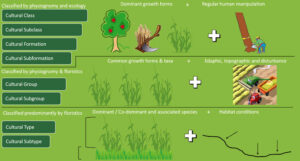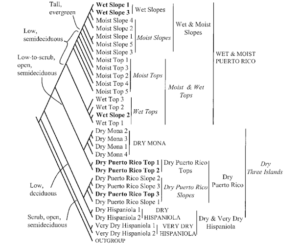Back to: Botany 500 Level
My Afrilearn brainiac, how your side today?
Na better day to learn something fresh! Today’s topic na Floristic and Physiognomic Classifications. E sound like big grammar, but no worry—we go break am down like suya. By the end of this gist, you go sabi how scientists classify plant communities using these two styles. Get your mind ready because this one go help you understand how to describe and group plants like real botanist wey dey field.
Floristic and physiognomic classifications
Wetin Be Floristic and Physiognomic Classifications?
When we dey study plant communities, we need to find a way to group or describe dem so we fit make sense of wetin dey ground. Two of the most common ways wey botanists dey do this na:

- Floristic Classification – Based on which species of plants dey the area.
- Physiognomic Classification – Based on how the plants look and the form or structure of the vegetation.
Make we enter each one well.
- Floristic Classification
This method focus on the actual species composition of a plant community. So, na the type of plants wey dey there we go use name or classify the area. Scientists go enter bush, record every plant species wey dem see, and use that list to describe the vegetation.
Example:
If you go inside a forest and you see that the area get plenty Milicia excelsa (iroko), Terminalia superba, and Khaya senegalensis (African mahogany), then the forest can be called a Khaya-Terminalia forest based on the dominant species.
Key Features of Floristic Classification:
- It gives detailed information about species present.
- E help for biodiversity studies, especially when you wan know if endangered species dey.
- Na usually done through field surveys and plant identification.
But… It can be challenging because plant species plenty and you need good identification skills. Also, two places fit look the same but get different species.
- Physiognomic Classification
Now, this one dey look plants from their appearance and structure. Instead of focusing on species, e check:
- Plant size (tree, shrub, grass)
- Arrangement (dense or scattered)
- Leaf type (broadleaf, needle-like)
- Growth pattern (evergreen or deciduous)
Example:
Even if you no sabi the name of the trees, if you see tall trees wey form canopy, with some smaller shrubs and thick undergrowth, you go classify am as tropical rainforest. Another place wey na mostly grasses with scattered trees na savanna.

Key Features of Physiognomic Classification:
- It’s simpler when you no fit identify every plant species.
- Useful for mapping vegetation over large areas.
- Good for ecological and land use studies.
So Wetin Be the Difference?
Floristic = Who dey there (name the plant species)
Physiognomic = How dem be/look (structure and form)
Real-Life Example in Nigeria:
- In Cross River National Park, scientists fit use floristic classification to describe it as a Khaya-Terminalia-Irvingia forest.
- But if dem dey do broader survey using physiognomic style, dem go just describe it as moist evergreen rainforest.
Why E Important to Know Both?
- Floristic helps for conservation and species-level work.
- Physiognomic helps when working on large-scale vegetation patterns, especially with remote sensing or GIS.
Na like saying floristic na to call person name, but physiognomic na to describe how the person look. You need both if you wan really sabi plant communities well.
Summary:
- Floristic classification is based on plant species present.
- Physiognomic classification is based on appearance and form of vegetation.
- Both help scientists understand and describe plant communities in different ways.
Evaluation:
- What is the main focus of floristic classification?
- Describe two characteristics used in physiognomic classification.
- Why is it useful to combine both classification types in plant ecology?
Correct! You just dey shine brighter every day, my Afrilearn superstar!
You don master how to classify plant communities like a pro—whether you dey call the plants by name (floristic) or describe how dem look (physiognomic). This na serious skill for any ecologist or botanist. Continue dey blaze trail like person wey sabi where e dey go. Afrilearn dey proud of you always. On to the next victory!
